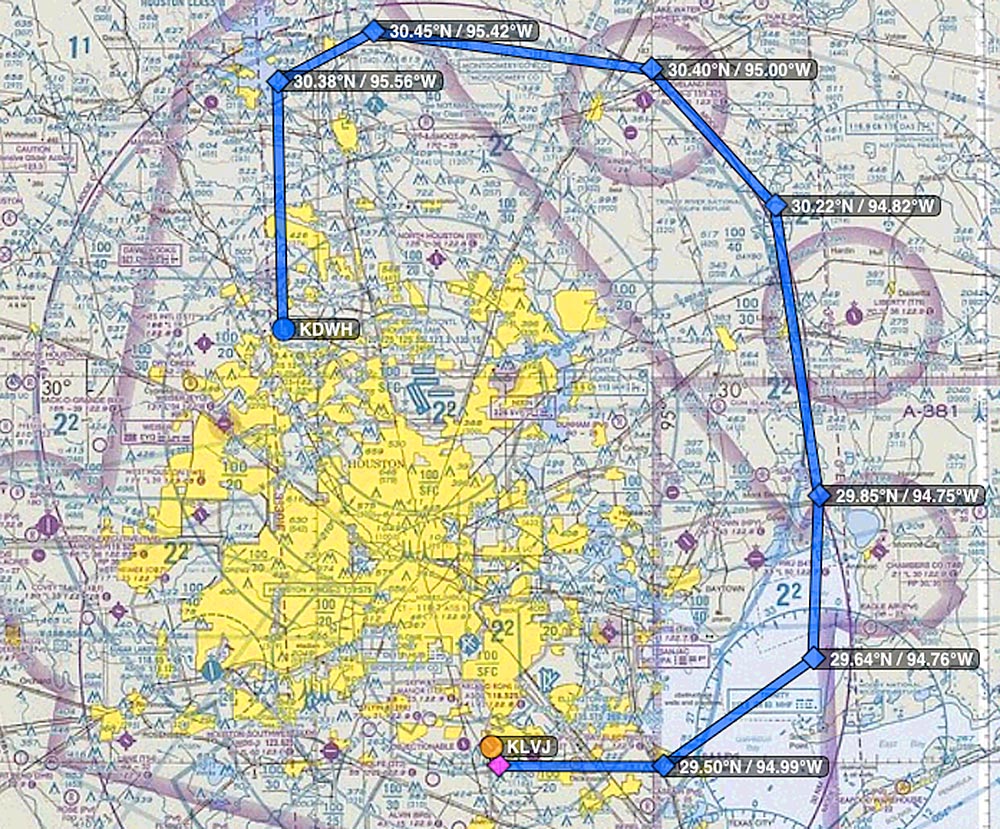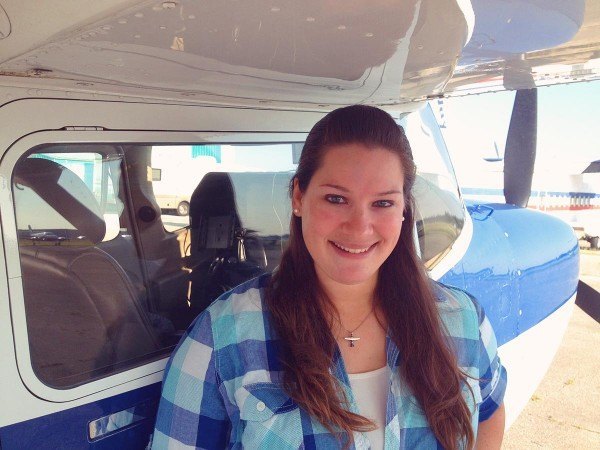Shana Bartell
Going Missed
by Sarah Rovner (Commercial Pilot and FAASTeam Representative)
It was supposed to be a routine solo flight – from Hooks to Pearland and back to drop off my aerobatic parachutes to be re-packed. I was in a Cessna 172 that was equipped with a Garmin 430 with WAAS and no autopilot or onboard weather. The weather was forecast to have low ceilings and fog roll in later in the evening, but when I left work and headed to the airport the weather in Houston was still VFR. I had gotten my instrument rating about a month before and figured that filing IFR was my solution to the forecast of deteriorating weather. By the time I got to the airport and pulled the plane out of the hangar, it seemed like the front was settling in. On my way down to Pearland, the ceiling kept getting lower and lower and was forcing me down until I finally called approach for a pop-up IFR flight plan and shot the RNAV 32 approach into Pearland. On final, I broke out of the clouds at about 800ft, although it wasn’t forecasted to get down to that until 5 hours later.
After getting to the airport, I gave my parachutes to a friend and stayed for a few minutes to talk. I kept an eye on the ceilings, and before I knew it, the METARs were reporting 400 overcast. My overconfidence took over as I said to myself “the airplane has WAAS, I can get down to 250ft almost anywhere in Houston with an LPV approach”. It might be legal, but definitely not smart. By the time I got back in the plane and was ready to go, it was nighttime out and the evening winter weather was bringing large masses of fog. I filed IFR from Pearland back to Hooks, which is a 42 mile flight. I didn’t expect it to take more than 45 minutes (including the approach), which I filed on my flight plan. At this point in time, I had 4 hours of fuel.
After getting my clearance, I got released to enter controlled airspace on an easterly heading. I thought this was a bit odd since the more direct route was to the west over Sugarland. As a new instrument pilot, I wasn’t pushy to ATC and just followed what they gave me. I took off and entered the clouds around 300ft and climbed up to 3000ft, which was my final altitude. I was by myself, in a single engine airplane, no autopilot or onboard weather, at night, and probably about my 5th time in IMC as pilot in command. I was invincible.
ATC vectored me all the way out toward Beaumont, and then started bringing me north. They asked me if I wanted the VFR corridor, and I said yes. However, they didn’t give me a turn and kept me heading north. They gave me a western turn far north of the Conroe airport and started to give me vectors for the Localizer 17R in Hooks, which the winds were favoring. By the time I started that approach, I had been hand flying in solid IMC for almost 2 ½ hours. I had now flown over 120 miles for a 42 mile flight. I was so far from Hooks at any given time that I couldn’t get the ATIS and find out just how much the weather was deteriorating. When I started the localizer approach, the clouds were reporting as 500ft overcast. By the time I passed the final approach fix, it was 400ft overcast. I never broke out of the soup, and performed my very first real life missed approach. The worst part is I could see the fog lighting up with the REILs flashing, but couldn’t see anything. I knew I was right over the runway, but couldn’t even see it.

After the first approach, I asked the controllers to try the RNAV 35L, because having WAAS allowed me to shoot the LPV approach which could get me about 200ft lower than the localizer 17R. They gave me vectors for the approach, and by this point I was sweating. I really wanted to see the runway and get on the ground. Unfortunately, the ceiling had gone down another 100ft as I started the RNAV 35L. I half broke out of the clouds, but could only see directly below me. I couldn’t tell the street lights from the runway, and couldn’t see any visible part of the airport by my missed approach point. So I went missed again. This is when ATC started taking me seriously. They asked me if I wanted to try the ILS 14 at Lone Star Executive Airport, which was my filed alternate. They also told me the weather was reporting 400ft overcast at CXO, and 800ft broken at College Station. I had to make the decision on whether to head directly to CLL or try CXO. I did a quick fuel calculation and realized I didn’t have enough fuel to do the ILS at CXO, go missed and still make it to College Station. I also didn’t have enough fuel for multiple approaches in CLL. By this point I had been flying for about 3 hours in the soup.
As anxious as I was, I made the decision to try the ILS in Conroe. I could make a few approaches into Conroe instead of just one in College Station. I also could have gone to Bush Intercontinental Airport if needed, which has runway centerline lights and leading lights so far from the runway that the lights would be much easier to see. So I decided to stay in the Houston area and try getting into Conroe.
As I was being vectored onto the final approach course, I was told to contact the Conroe tower. I told the Conroe tower where I was, and asked them to assist me in activating the lights. It was the same controller who worked my night emergency landing, and he could hear the stress in my voice. As I reached the final approach fix, the tower advised me that the rabbit was out of service. This just added to my anxiety as I focused on being right on to make sure I had the best chance possible to see the runway. As I was descending, the tower reported overcast at 300ft. This was it. I had to make it. A few feet above minimums, I saw the first half of the runway. It was the most beautiful thing I had ever seen, and I told the tower in excitement “I see it!”. I landed and taxied over to Galaxy FBO, who had stayed open a little bit later to see me in. I literally got out of the airplane and my legs were jello. I was tempted to kiss the ground but wasn’t quite sure what airplane had leaked on the pavement before me. I was so glad to be on the ground, and was very relieved that I made it in one piece.
As I was driven back to my home on I-45, I noticed that the fog had set in to the point that you couldn’t even see the streetlights on the side of the highway. IAH was now saying it was 100ft vertical visibility. I made it just in time before it would have been impossible to land a general aviation airplane in Houston.
As much as I would like to blame the whole ordeal on ATC, it was a combination of several things that got me into that situation. I wasn’t assertive enough to request a better route, I was overconfident in the equipment and had no personal minimums.  These 3 things combined made for a disastrous cocktail, and I’m fortunate that it turned out as well as it did. So I continue with my saying that just because it’s legal, doesn’t mean it’s smart!
These 3 things combined made for a disastrous cocktail, and I’m fortunate that it turned out as well as it did. So I continue with my saying that just because it’s legal, doesn’t mean it’s smart!
Sarah Rovner is a commercial airplane pilot based in Houston, TX who enjoys flying her G1000-equipped Cessna 182 for personal and business travel. She is also active as a mission pilot in the Civil Air Patrol, a humanitarian pilot with Angel Flight, a tow pilot for a local glider field, FAASTeam Representative and EAA Young Eagles pilot. She enjoys flying to and exploring new places, and is currently working toward her CFI rating.
Would you like more information?
Send us a message below.

